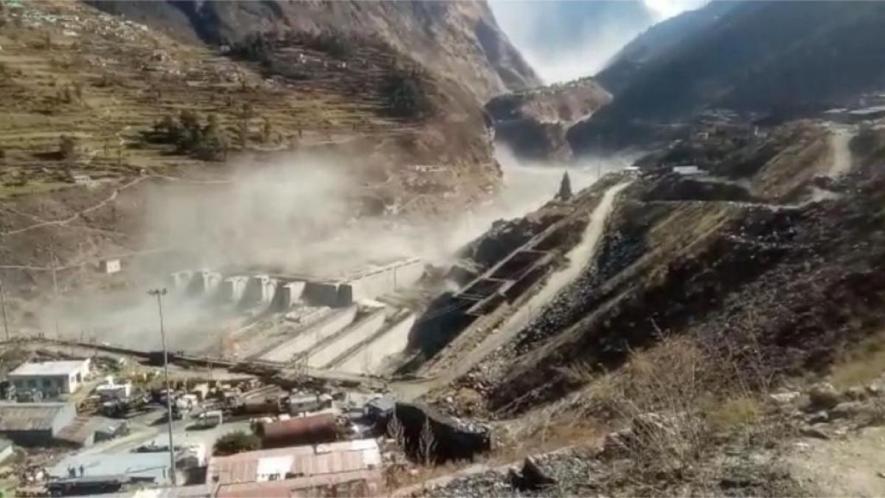Chamoli Disaster: SC Appointed Expert Says Char Dham Project May Cause Further Catastrophes

Image Courtesy: Down to Earth
Noted Uttarakhand-based environmentalist Ravi Chopra has written to the Supreme Court complaining of violations related to environmental concerns while carrying out the Char Dham Pariyojana. Chopra, who has headed an SC appointed Expert Body (EB) on hydro-electric projects and the High Powered Committee (HPC) on the 889-km Char Dham Pariyojana (road widening project) in Uttarakhand, expressed his fear that there may be further disasters like the Chamoli flash flood in the state.
The Chopra-led EB evaluated the role of 24 existing and under-construction hydro electric projects (HEP) in exacerbating the impact of the Kedarnath deluge in 2013 and found that 23 of them played a pivotal role in worsening the situation.
In his letter dated February 13, Chopra said that he was compelled to write to the apex court in light of the recent disaster in Uttarakhand’s Char Dham region. Two dams were destroyed in the Rishiganga and Dhauliganga (west) river valleys before the flood waters entered the Alaknanda valley below NH 58 (Rishikesh-Badrinath highway) and swept away another suspension bridge.
He said that he was given an opportunity in 2013 (Kedarnath tragedy) to chair an EB – through an order by the apex court – to assess the environmental degradation in the Himalayas due to hydroelectric projects (HEPs) and their role during the disaster. Notably, these HEPs are located in the Char Dham valleys of the Pariyojana.
The EB report submitted in April 2014 highlighted the potential threat of paraglacial zones, valleys north of the Main Central Thrust (MCT), and emphasised them as disaster-prone areas. (The Main Central Thrust is a major geological fault where the Indian Plate has pushed under the Eurasian Plate along the Himalayas.)
The EB recommended that HEPs should not be built in these valleys. Based on field visits, scientific publications, government reports and eye-witness reports, the EB report provided evidence of irreversible damage to the Ganga river system’s Himalayan ecology due to the construction of HEPs and their role in aggravating the destruction caused by the 2013 floods. The EB’s recommendations were accepted by the Ministry of Environment and Forest and Climate Change and placed before the court through its affidavit dated December 5, 2014.
Flood-related concerns in all existing projects, including shortcomings of the Tehri Dam, were also highlighted and the EB made recommendations for the development and installation of a flood warning mechanism. Chopra rued that had these concerns been addressed and the EB’s recommendations adopted, the massive loss of lives and property could have been avoided in the Rishi Ganga and Tapovan Vishnugad projects in Chamoli district.
He said that despite an SC stay on 24 proposed HEP projects which had not begun on-ground construction work, unfortunately, all the under-construction projects continued with construction work unhindered. He pointed out that in view of the precious ecology and fragility of the region, concerned authorities could have and should have taken a view on these projects. He stressed that the February 7 disaster had confirmed their fears and warnings. “Hundreds of crores spent in the last seven years for constructing these dangerous dams have ended up with the loss of over 200 persons, domestic animals and destruction of national property,” he wrote.
No decision, however, has yet been taken on the under-construction or commissioned projects. He added that had the stay not been imposed by the SC, three more under-construction projects just upstream and downstream of the Rishiganga HEP would have magnified the flood impact manifold.
Bringing the court’s attention to the Char Dham Pariyojana, he wrote that several chronic landslide-prone locations and stretches, where the slope stability is precarious, exist on the three Char Dham highways identified by the Ministry of Defence (MoD) as defence feeder roads. Ministry of Road, Transport and Highway (MoRTH) data submitted to the HPC have identified 161 sensitive locations in 574 km (on NH-94 Rishikesh to Uttarkashi, NH-58 Rishikesh to Mana and NH-125 Tanakpur to Pithoragarh), about one location every 3.5 kms.
The three member report dated December 31, 2020 to the Supreme Court, listed 42 locations on these three highways where frequent blockages were witnessed in just the monsoon months of 2020. There were many others during the remaining months of 2020.
“In the report submitted by myself and two members it has been strongly argued that disaster resilience is more critical than simply wide highways. Slope stabilisation works so far have been most inadequate as evident from the frequent failures and road closures. Excessive tree-felling, indiscriminate disposal of road construction and debris from landslides have endangered downhill slopes and polluted rivers,” he said. He added that instead of recognising the sensitive nature of the area, which is prone to disaster, the Union Ministries, MoRTH and the MoD have been shifting their positions,
Chopra cited specific instances of such shifts, saying that in March 2018, the MoRTH notified 5.5 m tarred width specifically for national highways in the Himalayan region, amending its earlier notification of 2012 defining a 10 m tarred surface for all national highways. However, the MoD, in its application dated November 27 last year, asked for a double-lane road with a carriageway width of 7 m is necessary to meet the Army’s requirements.
“Now MoRTH has again changed its view through an amendment in the 2018 circular on December 15 last year by reverting to its old standard (10 m tarred surface) of the 2012 circular. It defies the logic and evidence in its own notification of 2018,” the letter said.
Notably, more road width will result in more slope cutting, more tree chopping, more landslides and soil erosion and more muck dumping into rivers.
Chopra further wrote that the recent disaster happened in a region north of the MCT, which is highly prone to landslides, flash floods and earthquakes. “A section of the defense road to the Indo-China border and a bridge across the Rishiganga river on that road have been swept away, lending credence to our argument for disaster resilience in the region. Vulnerability and disaster proneness of this region is bound to increase with extensive disturbances like deforestation, slope cutting, blasting, tunneling, damming of rivers, excessive tourism, etc. The cumulative impact of such activities on the nearby glaciers cannot be ignore,” he wrote.
The SC, in its judgement dated August 13, 2013 in the Kedarnath tragedy had expressed concern “with the mushrooming of large number of hydroelectric projects in the State of Uttarakhand” and noted that “the cumulative impact of those project components like dams, tunnels, blasting, powerhouse, muck disposal, mining, deforestation etc. on eco-system, is yet to be scientifically examined.”
The Char Dham Pariyojana began later, without such a cumulative impact assessment, leading to the SC to express a similar concern by forming the HPC. “This concern implies the need to minimise environmental degradation of the sensitive Himalayan ecology in the Char Dham region,” he mentioned.
Chopra cautioned that to “ignore and override the profound and irreversible ecological damage to the Himalayas will severely impact each and every one of us and generations to come”, asking the concerned ministries involved in the project to desist from any such attempts.
In his letter, he said that it was “highly regrettable” that in its affidavit dated January 15, the MoD has imputed insincerity of motive and asked court to ask the ministry to withdraw such imputations.
“Our view is seriously concerned about protecting the Himalayan Ecology, which is also the concern of Supreme Court. Instead of appreciating that our report is based on scientific analysis of the available evidence and the tragedy which took place in 2013, it is highly regrettable that in its affidavit of January 15, the MOD has imputed insincerity of motive . This Court may ask the MOD to withdraw such imputations. We may emphasise that no convincing argument exists in the recent affidavit of the MoD to ignore and override the profound and irreversible ecological damage to the Himalayas that will impact each and every one of us and generations to come (sic),” he concluded his letter.
The writer is an independent journalist who writes on the environment, wildlife, climate change, social and gender issues.
Get the latest reports & analysis with people's perspective on Protests, movements & deep analytical videos, discussions of the current affairs in your Telegram app. Subscribe to NewsClick's Telegram channel & get Real-Time updates on stories, as they get published on our website.
























